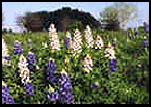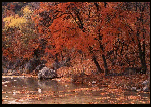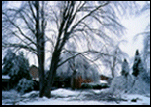|
(936)-273-2218 | (281)-419-8752 |
 |
 |
 |
 |
|||
| No matter the season, we keep you comfortable | ||||||
|
(936)-273-2218 | (281)-419-8752 |
 |
 |
 |
 |
|||
| No matter the season, we keep you comfortable | ||||||

Understanding and Controlling Mold
Where does mold come from?
Molds are microscopic fungi. Like dust and pollen, their spores float freely through the air. Lacking roots, stems, and leaves, molds can grow on virtually any organic substance so long as oxygen and moisture are present. Molds grow readily on many materials commonly found in homes including insulation, carpet, wood, furniture, clothes, food and paper. Mold begins when its spores land on a moist surface, germinate and begin to grow. It grows by gradually digesting whatever medium it is growing on. Outdoors this process serves a necessary function by aiding in the decay of fallen timber, dead leaves, and other debris. Molds also play a beneficial role in the production of antibiotics, such as those produced from penicillin or cephalosporin.
You can't see mold spores, but you can see and smell mold once the spores have germinated and the mold has begun to grow. It gives off a musty, slightly rotten odor." [Mike McClintock "How Household Mold Gets a Grip" from The Washington Post. September 12, 2002]. Molds come in a variety of colors (black, white, green, brown, and orange) and form a furry coating on the solid substance on which they are growing.
What kind of health complications do molds cause?
Opinions on the role mold plays in health complications vary widely. The general consensus holds that certain types of mold act as allergens which produce allergic reactions in sensitive individuals. When a mold sensitive individual inhales mold cells, the immune system responds by producing histamines to expel the mold cells from the body. Symptoms of this allergic reaction may include nasal discharge, watery eyes, sneezing, a sore throat, and itching.
While many types of mold exist, only a few dozen have been linked to allergies. The most common culprits are alternaria, cladosporium, aspergillus, penicillium, helminthosporium, epicoccum, fusarium, mucor, rhizopus, and aureobasidium. Harvard's mold expert, Harriet Burge, says mold only becomes a health issue when there's too much of it and that the "too much" threshold varies from one person to another. (Christopher Wanjek, "Tales About Rampant Toxic Mold Get Plenty of Attention, but Science Tells a Less Dramatic Story" from The Washington Post, September 17, 2002).
In some sensitive individuals, exposure to certain molds may trigger asthma attacks. In a few people, including those with compromised immune systems, the inhalation of certain mold spores may cause respiratory damage. People suffering from chronic obstructive pulmonary disease may actually develop mold infections in their lungs.
Are molds toxic?
The toxicity of molds is a controversial subject. A greenish-black mold named stachybotrys chartarum may, under certain conditions, produce toxic chemicals known as mycotoxins. Individual reactions to the presence of stachybotrys chartarum vary widely. Some people are not affected at all, while others may become seriously ill. Stachybotrys chartarum requires nearly saturated conditions to thrive and may be found where moisture has accumulated from roof leaks, wall leaks, chronic plumbing leaks, or flooding. It often grows in hidden places (such as inside walls) where a leak or moist conditions have gone undetected. Stachybotrys chartarum does not always show up in air samples. Its spores, when wet, are sticky and do not readily aerosolize, so there may not be enough airborne spores to show up in an air sample. Even when airborne spores are captured in a sample, they do not grow well on standard sampling media and may not survive to the identification stage. Direct tape-lift samples of mold are the best method for testing and identifying stachybotrys.
How can I discourge mold?
The key to discouraging mold is to keep your home clean, dry and in good repair. While mold spores are often present in the air, they require damp surfaces in order to grow. Once mold has seriously contaminated a home, it can be difficult to eradicate. While it's not always possible to protect against unexpected water leaks, here are some things you can do to discourage the growth of mold .
Maintain Plumbing
Examine your pipes periodically for rust or white lime deposits which may indicate a slow leak. If you find a leak in your plumbing, call a plumber. Pipes, tanks, and other fixtures which continue to sweat for hours after the water has been run may be symptomatic of a leak or of a tank valve needing readjustment.
Maintain Your Heating and Air Conditioning System
The American Lung Association recommends that indoor humidity be maintained between 40 and 50 percent. These levels can be difficult to achieve during Houston's most humid months. However, keeping indoor humidity below 60 percent should discourage the growth of mold. The best way to control indoor humidity is to have a properly sized, well-maintained air conditioning system.
When purchasing air conditioning equipment, have a qualified air conditioning technician run a heat load and advise you on the proper equipment size. If your equipment is too large for the space you are cooling, it will reach the desired temperature too quickly and will cut off before it has adequately dehumidified the air. Likewise mismatched systems may not properly dehumidify the air.
Have your air conditioner inspected and serviced annually to make sure that it is running properly, that the drain pan is free of cracks and holes, and that the drain lines are clear. Many air conditioning companies (ACU Air included) include an algaecide treatment with the inspection. This discourages the grown of algae in your drainlines and thereby reduces the risk of water damage.
If your air conditioning system does not already have one, have a float switch installed in your unit's drain pan. In the event that your drain lines should clog, this switch will shut off your air conditioner before water from your unit's condensation backs up and saturates nearby insulation or seeps through your ceiling.
Keep the air flowing freely.
Restricted air flow can cause your air conditioning system to release moisture. To maintain optimal air flow, change your air filter once a month. If you use an electrostatic air filter rather than standard disposable filters, be sure to remove it and clean it monthly (a good rinse with the garden hose should do the trick).
Maintain air circulation around your outside condenser unit. Do not plant or allow heavy vegetation to grow around the unit. Keep any lawn adjacent to the unit mowed and take care not to blow grass clippings into the unit. Watch for and destroy any ant mounds around the unit.
The air conditioning technician who inspects your cooling system each spring will advise you if your coils have become encrusted with dirt. Dirty coils should be professionally cleaned so that your air conditioner can effectively cool and dehumidify your home .
Ask your air conditioning technician whether the refrigerant lines in your attic are properly insulated. Non-insulated lines may sweat and drip moisture onto the woodwork or insulation below.
Vent moisture-generating appliances, such as dryers, to the outside where possible.
Make sure your home is well insulated
Temperature diffierntials within your home can result in condensation where warm, moist air comes into contact with relatively cool surfaces. When a ceiling (or the attic above it) lacks insulation, the warm upper air may condense on the higher portions of the walls, creating a moist surface conducive to mold.
Provide drainage and slope the ground away from your foundation.
Keep your foundation clear of leaves and pine needles. Mold thrives in damp organic material.
Keep your gutters clean
Mold grows in damp, decaying leaves. The more leaves your gutters collect, the less efficiently it will drain water away from your house and the leaves themselves make a perfect media for growing mold.
Keep your kitchen and bathrooms clean and dry
During and immediately after running showers and bath water, open your bathroom window or run the ventiliation fan. After showering, leave shower curtains spread their full width so they can dry.
Scour sinks, tubs, shower stalls, and countertops regularly with bleach based cleansers. Molds thrive on soap and other films that coat tiles and grout.
Clean refrigerator door gaskets and drip pans with a bleach based cleanser.
Throw away or recycle old newspapers, clothing or bedding.
Mold readily grows on paper and fabric. Newspaper, clothing, and bedding stored in the garage and attics are more prone to mold because your heating and cooling system doesn't dehumidify these areas. If you find evidence of mold in a closet, consider replacing the solid door with a wicker door so that your heating and cooling system can dehumidify the closet's interior or leave the door open during the day.
Dry clean rather than steam clean your carpet.
Steam cleaning your carpet introduces a tremendous amount of moisture into your home and temporarily increases your home's humidity levels, making it more conducive to mold. If your steam cleaned carpet takes more than 24 to 48 hours to dry, mold spores may germinate in its fibers. Just as there are professional steam cleaners, there are professional dry cleaners who will come clean your carpet, or you can dry clean your carpet yourself. Dry cleaning kits are available at many hardware stores, such as Sears and Home Depot. Vacuum your carpet thoroughly before applying the dry cleaning powder. Use a long handled brush to work the powder into the carpet . Allow it to sit at least thirty minutes, then vacuum it out. Note: dry cleaning will not remove existing mold from your carpet. Mold infected carpet and pads should be removed and replaced.
Leave your air conditioner on when your home is vacant
If you travel during the summer or if your house is vacant for any other reason (maybe you have moved out and are getting ready to sell it), it is important to leave your air conditioner on. You may want to increase the setting to eighty degrees to save on electricity. However, turning off the ac all together will cause the air inside your home to become not only hot but humid. Such conditions encourage the growth of mold.
Install an air purification system.
If your home has had a mold infestation in the past, if an air conditioning technician observes evidence of mold inside your cooling and heating system, or if anyone in your household suffers from allergies or asthma, consider having a mechanical air cleaner and an ultraviolet air disinfection system installed. Mechanical Air Cleaners, are 80% to 95% effective in removing the airborne pollutants, including the smaller particles which readily pass through standard cardboard and electrostatic filters. A mechanical air filter consists of a case and a HEPA filter. The HEPA filter should be replaced once a year.
The ultraviolet air disinfectant system emits intense ultraviolet rays which penetrate airborne particles. These rays sterilize or kill most contaminants including mold. The system's UV lamp should be changed about once a year (or after a maximum of 9,000 hours) to work effectively. Do not have an ultraviolet air disinfectant system installed without a mechanical air cleaner. If you do, the UV lamp will quickly become coated with airborne particles and won't effectively carry out its function.
How do I get rid of mold?
Technically, it's impossible to completely eliminate mold; invisible to the eye, the spores exist in the air both outdoors and indoors. However you can eradicate visible mold and prevent mold from growing. If you are treating a home for mold, you must first eliminate or fix whatever is causing the moisture. Next you must clean or replace all mold infected items. Finally you should have your cooling and heating equipment and ducts inspected for mold.
Attacking the Mold
If you have identified and eliminated the source of moisture and the mold growth covers no more than thirty square feet inside your home or place of business, you may be able to remediate the contaminated area on your own. During a mold removal and remediation project, the mold spore count in the air can increase 10 to 1,000 fold. When removing mold, wear gloves, goggles, protective clothing which can be laundered, afterwards, with chlorine bleach, and an N-95 particulate respirator or breathing mask approved by the National Institute for Occupational Safety and Health. The mask should cover both your nose and mouth. If you suffer from allergies, asthma, or respiratory disease or are immune depressed, you should not personally engage in any mold removal project. While written primarily for remdiators of schools and commercial buildings, the EPA's booklet Mold Remediation in Schools and Commercial Buildings contains useful information on restoring homes and other buildings infected with mold.
Cleaning and Replacing Mold Contaminated Surfaces and Items
Mold can be destroyed and cleaned off non-porous materials, such as metals, hard plastics, and glass. Semi-porous materials such as wood (provided moisture levels are below twelve to fifteen percent), plaster, and concrete, if structurally sound, can often be cleaned and reused as well. However mold cannot be effectively removed from pourous items such as carpet, rugs, upholstery, ceiling tile, wallpaper, and mattresses. Such items should be disposed of and replaced. To remove mold from non-porous and semi-porous surface:
- Spray the moldy surface lightly with a water-and-detergent solution to help keep mold dust and spores from getting into the air.
- Using a bleach-based cleaner and hot water, thoroughly scrub all moldy surfaces. Rinse the scrubbed surfaces. A wet-dry vacuum may be used to collect excessive water.
- After cleaning and while still wearing a mask, apply a disinfectant solution made up of 1 to 1½ cups of liquid chlorine bleach to one gallon of water to the affected surface. Warning: never mix bleach with ammonia as this will create toxic fumes.
- Allow the disinfectant to remain on the surface for 6 to 8 hours so that it dries naturally.
- After the disinfectant process has been completed, the affected surfaces should be dried as quickly as possible. Use fans and/or dehumidifiers to speed up this process. If the surfaces remain damp, the mold is likely to regrow.
Remediating Your Air Conditioning and Heating System
In the average home, air recirculates through the air conditioning and heating system forty to seventy-five times a day. If mold is growing profusely inside a building, its spores will enter and may contaminate the air conditioning and heating system. Left untreated, the system will subsequently recirculate mold spores into the home or place of business. Have a qualified service technician should inspect your evaporator coil and your heater assembly for evidence of mold. If he observes evidence of contamination, the evaporator coil should be chemically cleaned. Likewise, the heater's motor housing should be disassembled so that the housing and the blower wheel can be professionally cleaned. In some rare cases, it may be necessary to replace the evaporator coil and or the heater to get rid of the mold.
If mold is growing on any of your supply air or return air grills, the grills should be replaced.
If mold has been found in your home, the insulation in your attic should be inspected for mold. Any mold infected insulation should be replaced.
An air conditioning service technician or a duct cleaning company should inspect your ductwork for mold. Duct systems are generally constructed from sheet metal, fiber glass, or some combination of the two. As a general rule, ducts constructed exclusively from sheet metal can be cleaned as can ducts constructed with sheet metal on the inside and fiber glass on the outside. Ducts lined internally with fiberglass insulation cannot be cleaned. These ducts, when contaminated with mold, should be replaced.
If you have your ducts cleaned, make sure that the duct cleaning company cleans the entire interior of the ductwork. Some companies clean only the first few feet of duct inside each grill. The duct cleaning company should treat your ducts with a fungicide at the time they are cleaned.
Once your heating and air conditioning system, including the ductwork, has been cleaned, do not run your heater or your air conditioner until after all other mold remediation has been completed. Running your heater or air conditioner before the remediation has been completed will reintroduce mold spores into your system and recontaminate it.
Because it is virtually impossible to eradicate all mold spores from the interior of a building, consider having a mechanical air cleaner and a UV disinfectant system installed. The UV disinfectant system uses powerful ultra-violet light to kill mold spores. However, to work, this UV bulb must be free of dust. A standard disposable return air filter screens out only fifteen-percent of the particles which pass through it, meaning that eighty-five percent of the particles will get through and quickly coat the UV bulb, rendering it useless. The media filter used by a mechanical air cleaner will filter out some ninety-five percent of particles, keeping the UV bulb clean and enabling it to do its job. Even so, the UV bulb should be replaced annually as it will burn out over time.